Renovated Manti Temple, preserved Minerva Teichert murals ready for 3-week public open house
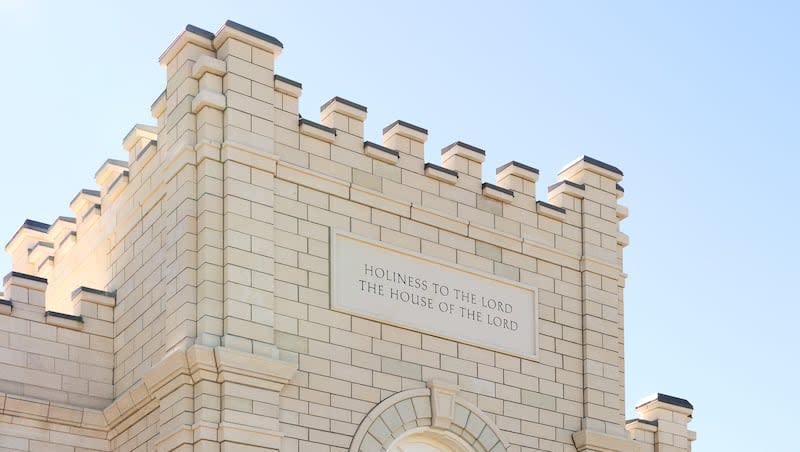
- Oops!Something went wrong.Please try again later.
- Oops!Something went wrong.Please try again later.
For a century, water seeped into and damaged the pioneer-era Manti Utah Temple’s walls and the plaster under the historic temple’s cherished murals by masters like Minerva Teichert and C.C.A. Christensen.
The damage extended to the murals themselves. Now, that threat is gone, a church historian said after a tour for journalists Monday morning at the third-oldest temple of The Church of Jesus Christ of Latter-day Saints.
After a 29-month renovation that included intense water mitigation as well as restoration and preservation work, the church is ready to welcome the public over the next three weeks to the first open house at the Manti Temple since 1985. Free reservations for tours between Thursday and April 5 can be made online at ChurchofJesusChrist.org.
“We welcome the world,” Relief Society General President Camille N. Johnson said. “We’re happy to have them have an opportunity to see what’s happening inside the temple before it’s dedicated. Come and see. Come join us. Particularly those people that live in the Sanpete Valley and the surrounding areas, this is an opportunity for them to learn more about this temple on the hill, the light, the beacon that they surely see from all over this valley.”
Church leaders and historians hosted the media tour. They celebrated the restoration of the temple’s famed artwork. Room by room and in detail, they explained the efforts made during the renovation to conserve the Teichert murals and the other artwork in a temple that President Russell M. Nelson called a “unique treasure.”
They also shared the reasons Latter-day Saint pioneers devoted themselves to building a sacred space in the form of a towering stone temple full of intimate and intricate craftsmanship — devotion to Jesus Christ and to returning home to live with God as families bound together by temple ordinances.
They explained the Latter-day Saint theology that underpinned the original construction and craftsmanship as well as the ongoing sacrifices in time and effort that church members make at temples today.
“I hope people will come to the open house and leave with a better understanding of why the temple is so important to us, why their pioneer forefathers and foremothers made dramatic sacrifices to build this temple,” President Johnson said. “It may sound perplexing to somebody who doesn’t understand why we do what we do and what’s happening inside the temple. I think the open house will provide a more complete understanding for those people who are not members of the church.”
Why did pioneers sacrifice to build the Manti Utah Temple?
Brigham Young sent 224 pioneers to the Sanpete Valley in November 1849. Soon, wind and snow drove them to seek shelter in dugouts on a side of a hill. When spring came, both the settlers and several hundred rattlesnakes were surprised to find that the other group had wintered on the same side of the same hill.
That hill became both a stone quarry and, with construction beginning in 1877, the site of the Manti Temple, which is built from the quarry’s oolite limestone.
“The temple is built literally from the hill,” Emily Utt, historic sites curator with the Church History Department, said.
The cost was $1 million, but church members provided the majority of that with livestock and other commodities. They also committed time and labor.
That raised a question a church leader posed to journalists on Monday.
“Perhaps the question that we could ask ourselves is why? Why did these saints, why did these pioneers sacrifice everything that they had so that they can build this holy House of the Lord, this holy temple?” said Elder Jonathan S. Schmitt, a General Authority Seventy and assistant executive director of the Temple Department.
“As you have the opportunity to enter into the temple, you’ll notice that the artwork, that the murals are stunningly beautiful. Yet this is not an art gallery.
“You’ll find that the craftsmanship in the spiral staircase, every detail is intricate, and it’s beautiful,” he added. “Yet this isn’t a museum of architecture and design.”
He said everything about the temple points to the Savior Jesus Christ.
He shared the story of a Latter-day Saint carpenter who suffered a strangulated hernia while lifting the heavy east doors into place. The injury claimed the life of George Francis Paxman, who was 24. His wife, Martha, delivered their second child eight months later. Two months after that, she attended the temple dedication in the Assembly Room on the third floor, entering those east doors.
Their granddaughter, Sister Marjorie Pay Hinckley, told that story about her grandmother, who lived 66 years as a widow, at the request of her husband, church President Gordon B. Hinckley, during the 1985 rededication of the temple.
“Today, I hope you’ll see beyond the outward, beyond the furnishings, and see into the hearts of these pioneer Saints,” Elder Schmitt said. “I believe that you will feel of their spirit today. It was because of their faith in Jesus Christ that they built this temple. It’s because they knew that this is the place where they could be endowed with heavenly power to help them endure life’s challenges and life’s trials.
“They knew that it was here that they could be bound and sealed together as families, not simply until death do you part, but for time and for all eternity. So those wonderful saints, those hardworking, those gritty saints, living in homes with dirt roofs, gave everything they had to construct this holy temple.”
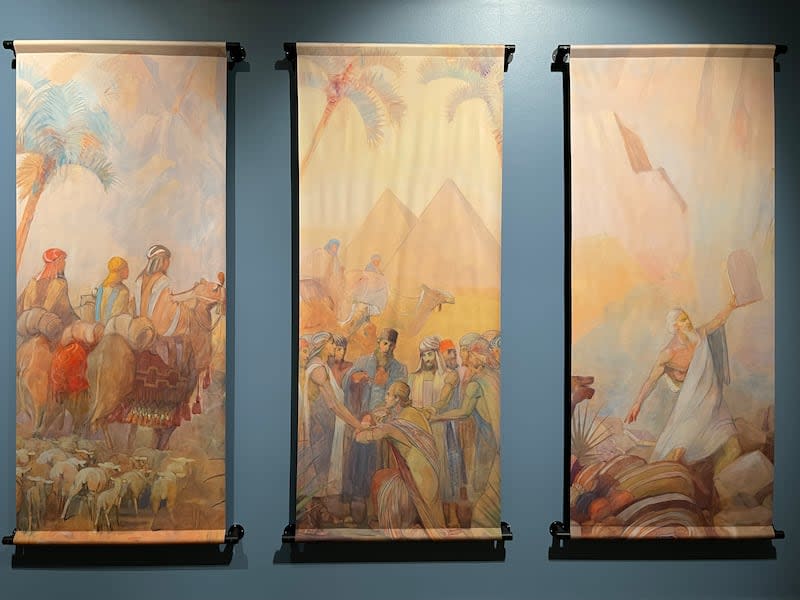
How did workers preserve the Minerva Teichert murals and the temple?
The water that damaged the temple for decades also destroyed the original murals painted directly on the plaster walls of the World Room, an instruction space. In 1947, Minerva Teichert painted new murals on the 4,000 square feet of sail canvas covering new plaster on the room’s walls, wrapping around doors and under windows.
She painted “The Pageant of Nations” in 23 working days, President Johnson said. “It is a grand pageant,” President Johnson said, “with 120 characters marching by in grand view.”
Still the relentless water threatened her works, including the building of the Tower of Babel on the east wall and scenes on the south wall of Moses with the 10 commandments, Joseph being sold into Egypt and Abraham leading his sheep.
It was time to plug the leak, once and for all. The temple was built into the hillside, so the solution required a massive excavation to separate the east walls from the hill.
“I am not concerned about water on this temple,” said Emily “I think we’ve done a very good job and the work that we’ve done to conserve the murals hopefully means that we don’t have to be back working on them for 50 years. Just don’t touch them when you’re in the temple.”
She described how backhoes cut a swath of earth 20 to 30 feet away from the temple, digging down below the temple’s walls and foundation to its footings. A gravel bed was inserted as a drain. Waterproofing material was inserted between the hillside and the temple.
The walls also were cleaned. The oolite limestone is a bright but warm, tan color. Utah’s contribution to the Washington Monument was quarried from the hill, a slab that bears the all-seeing eye.
“You see this oolite limestone all over the state of Utah, because it’s just, it carves like butter,” Utt said. “It’s just so good, but it holds up really well, and it withstands the elements. It’s everything you want in a good stone.”
Meanwhile, conservationists went to work on the murals.
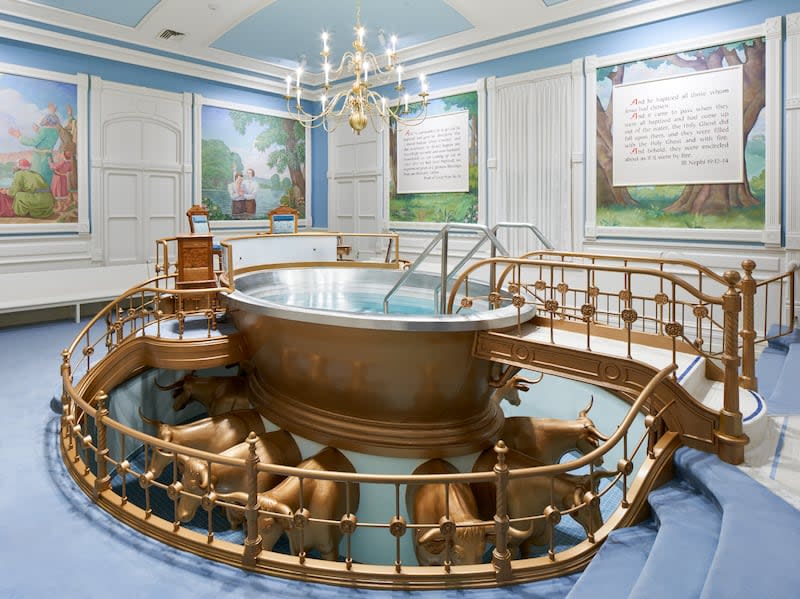
The baptistry
The murals in the Manti Temple’s baptistry are of Jesus Christ’s baptism, Joseph Smith baptizing Oliver Cowdery in 1829 and the scene of a Book of Mormon-era baptism. They were painted in 1948 by Robert L. Shepherd.
In Latter-day Saint theology, baptism is the first ordinance on the path back to God. Temple ordinances are performed for both the living and dead. For example, in temples, church members are baptized as an ancestral gift to those who died without baptism.
From the Manti Temple’s opening in 1888 through 1991, Latter-day Saints performed 4.5 million vicarious baptisms for the dead. Ancestors can choose to accept or reject those vicarious baptisms in the afterlife, according to church doctrine.
During the same time period, church members also performed 85,182 endowment ordinances for the living and 4.2 million vicariously for the dead. The endowment provides instruction and, through promises made with God, blessings of power for life. Over those 104 years, church members performed a total of 13,070,050 ordinances in the temple, according to the book “The Manti Temple.”
But the plaster behind the baptistry murals was separating from the walls when the temple closed for renovation on Oct. 2, 2021.
“It was actually causing damage to the murals because the plaster had failed and was just lying loose in the cavity behind them,” Utt said. “So we very carefully removed those murals.”
They were sent to Parma Conservation’s labs in Chicago.
“They cleaned all of the plaster off the back of the canvas, suctioned everything nice and tight, and then we came in and replastered the walls in the baptistry and then reinstalled the murals,” Utt said.
She noted that the 12 oxen that bear the baptismal font in the baptistry were made from a cast used for the other pioneer-era temple fonts in St. George and Logan.
The oxen represent the gathering of the 12 tribes of Israel to the temple, to Jesus Christ and to families, Elder Schmitt said.
The baptistry’s walls also carry four large scripture passages, each verse beginning with a beautiful, red scripted drop cap letter.
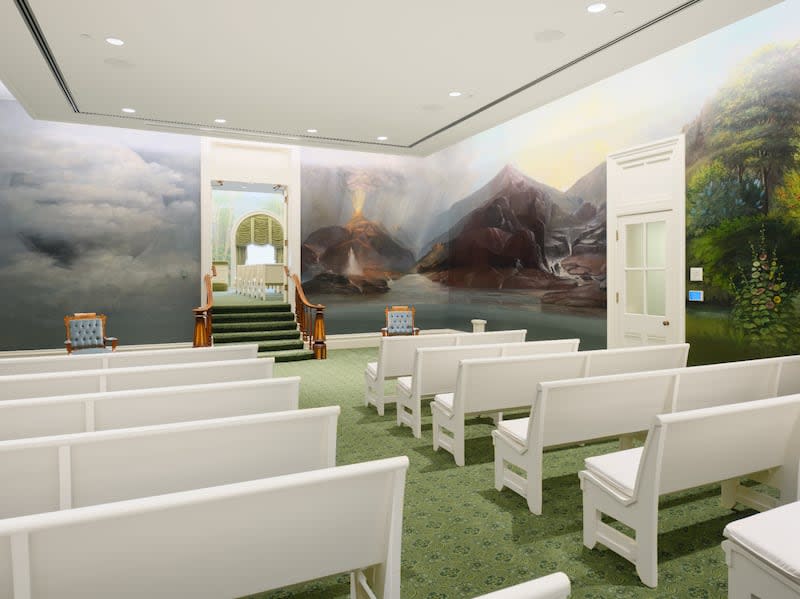
The Creation Room
The Manti Temple’s four instruction rooms, which are part of the endowment ordinance, begin on the first floor and on the second, each room a few steps above the other to show progress toward a return to living with God.
C.C.A. Christensen painted the Creation Room in 1886-87, and those murals are now the oldest existing murals in the church, Utt said.
The paintings begin with a newly formed but indistinct earth, then move forward in the history of the creation around the room, from the scene of an erupting volcano to the first dawn as the sun rises over mountains to the appearance of plants and then Jurassic-era animals followed by more modern animals and sea life.
Utt said Christensen drew inspiration for the dinosaurs from the book, “The World Before the Deluge.”
“At the time, science is cool, and people are finding dinosaur bones,” she said.
The Manti Temple was the last Latter-day Saint temple to provide a live-action endowment ordinance. When the temple is rededicated on April 21, the ordinance will be a film production as it is in all other temples.
Elder Schmitt said the change is to make every endowment session available to people of all languages. The film projector hangs from the ceiling on one end of the room and projects on a screen that drops from the ceiling on the other end.
The Christensen murals were painted directly on the plaster and have been under a century-long attack by water.
“We removed 100 years of grime, gunk and varnish and overpaint,” Utt said. “The mural had been repaired multiple times, and by people that were well intentioned but maybe weren’t using the right materials. We think the varnish that was on the murals before this renovation was added probably in the 1920s or 1930s.”
The chemicals in the varnish began to crosslink with the chemicals in the oil paints, which means they were becoming one chemical. That process had started, so removing the varnish was incredibly difficult, she said.
“The conservators tell us this was the hardest conservation job that they’ve ever done, and that at some point, if we hadn’t removed that varnish, it was going to be so linked together that the varnish would never come off, and eventually would get harder and harder and then turn the mural black, and then the content would disappear.”
Conservators removed all the previous repairs and infills and damage and then carefully restored the murals.
They covered the murals with new, conservation-grade varnish that won’t crosslink and is easily removable, Utt said.
The Garden Room
The original Garden Room murals from the 1880s were destroyed by the leaks. They were repainted in 1945 by Joseph Everett, who died after completing one wall, and Robert L. Shepherd, who did the baptistry murals.
The Garden Room depicts the Garden of Eden, including the Tree of the Knowledge of Good and Evil and the Tree of Life, representing the decisions Eve and Adam made to choose agency through the Fall.
“The conservation of the Garden Room and the World Room was much simpler,” Utt said. “Those murals, and the baptistry, as well, are all on canvas. So in the Garden Room and the World Room, it was mainly a matter of doing a couple little crack repairs. Some of the glue, the adhesive that had been put on in the 1940s, had started to fail a little bit, so we injected a little bit of new adhesive to touch up, repaired the crack, put some new varnish on it and moved on.”
The Garden Room represents vital Latter-day Saint theology. For example, the murals depict a lioness lying down with a lamb, an impossibility in the fallen world where the lioness is predator and the lamb is prey, said Sister Nuria Alvarez de Martínez.
“We know that after this moment of peace in the Garden, there is going to be a fall,” she said. “They’re not going to be friendly after the fall, but there will be a time when they will be able to be together again after the Second Coming of Jesus Christ.”
Latter-day Saint theology includes gratitude for Adam and Eve and the Fall.
“That was a fall forward,” President Johnson told journalists. “Sometimes we think about falling backward or falling down. We’re going to ascend this staircase (from the Garden Room to the World Room) into the world in which we presently live. The Fall was forward movement, it was a blessing for us to progress towards a return to our heavenly home.”
The altar in the Garden Room symbolizes the Atonement of Jesus Christ, said Elder Hugo A. Martínez, a General Authority Seventy who is a counselor in the Utah Area Presidency.
“Because of his atoning sacrifice and the covenants and promises we make to him and our Heavenly Father, as we progress through the presentation of the endowment, we are bound to and we promise to follow covenants so that we can become his disciples here on earth and that allow us to be with them in the future,” he said.
The World Room and Minerva Teichert
Teichert’s renowned murals in the World Room begin on the back wall with the Tower of Babel, which represents the scattering of people, President Johnson said. Teichert depicts parallel gatherings on the long sidewalls.
One one side is the gathering of the scattered tribes of Israel, with Abraham, Joseph and Moses and Pilgrims arriving in North America. On the other side is the gathering of others, represented by people from the far east bearing symbols of their religions, crusaders and Columbus on a ship.
The groups converge toward the north wall where a Native American chief, out of the 120 people depicted, is the only one looking at the audience in the room. He spreads welcoming arms. Behind him is a Zion community in a valley below.
“We’re here in this earthly life in the world, blessed by the covenants we make here, with an opportunity to return home, to return to Zion, and that’s what Minerva Teichert so beautifully depicted,” President Johnson said.
She said Teichert is an example of a person “who consecrated her time and her talents to adorning the house of the Lord in a way that’s fitting in his presence.”
Utt said the room was in good condition. After conservation work, the Teichert murals were covered with conservation-grade varnish.
“The Minerva Teichert mural in this temple, I would say, is 98% original mural,” Utt said. “There’s been a little bit of damage, a little bit of repair but the Minerva Teichert mural in general was in very, very good condition. We had some glue problems that were easy to resolve. We had a couple of cracks in the canvas, but it was really a relatively minor fix. Minerva Teichert’s mural, as installed by Minerva in 1947, is almost exactly the mural that you see today.”
Jeff Teichert, a great-grandson of the artist, told the Deseret News he was grateful the church conserved the murals.
“I believe this spectacular room is the equivalent of a Latter-day Saint Sistine Chapel, though I am concededly biased,” he wrote on Facebook. “I am grateful for this heritage of faith and family in a place where we symbolically walk through this world and back into God’s presence in eternity.”
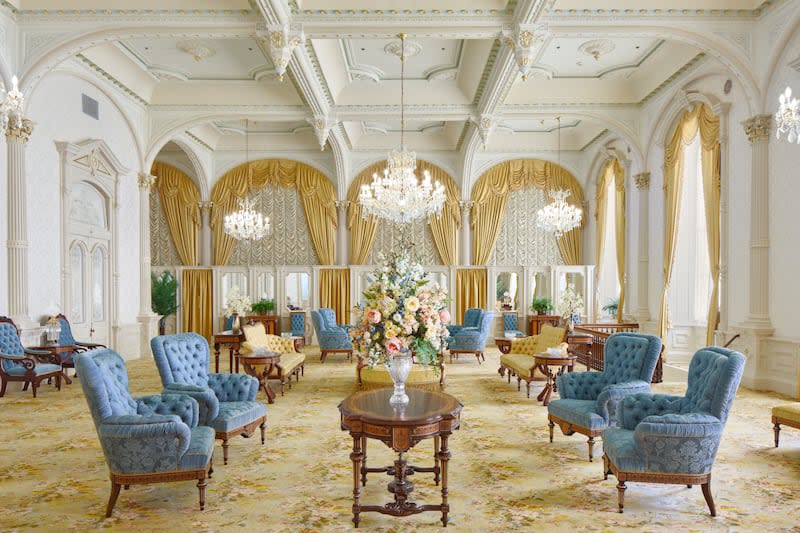
The Terrestrial Room and Celestial Room
Moving toward the presence of God, the endowment ordinance again moves upstairs into a grand terrestrial room and then the Celestial Room, which represents the place were God dwells. Latter-day Saints sit and pray and ponder in quiet peace in this room after temple ordinances under high ceilings and five chandeliers.
They consider it “one of the holiest and most sacred places on earth that represents being in the presence of God,” Elder Schmitt said.
He invited journalists to do as Latter-day Saints do in the Celestial Room.
“What would you do if you were in the presence of God” he asked. “That is the place where as members of the church we come seeking light, where we come seeking answers, where we come seeking comfort when we’ve had concerns with our children. Family members will come to the celestial room and we will pray and seek help from God, seek blessings for our family.”
The chandeliers in the Celestial Room and sealing rooms, where a man and a woman are sealed in marriage and children are sealed to parents for eternity, symbolize that those are rooms where heaven and earth connect, Elder Schmitt said.
Like most of the temple’s rooms, the Celestial Room has windows for looking out over the valley, making it a place for pioneer respite from daily struggles in the 1880s and for similar rest for worshippers in the future.
Elder Martínez said the temple’s separate rooms work to bind families together.
“We go through the temple to reach the sealing rooms,” he said. “That is the highest ordinance we receive, the promise of families. In heaven, we won’t be organized as wards and stakes. There will be families.
“It brings great hope and peace to us, and it drives us.”
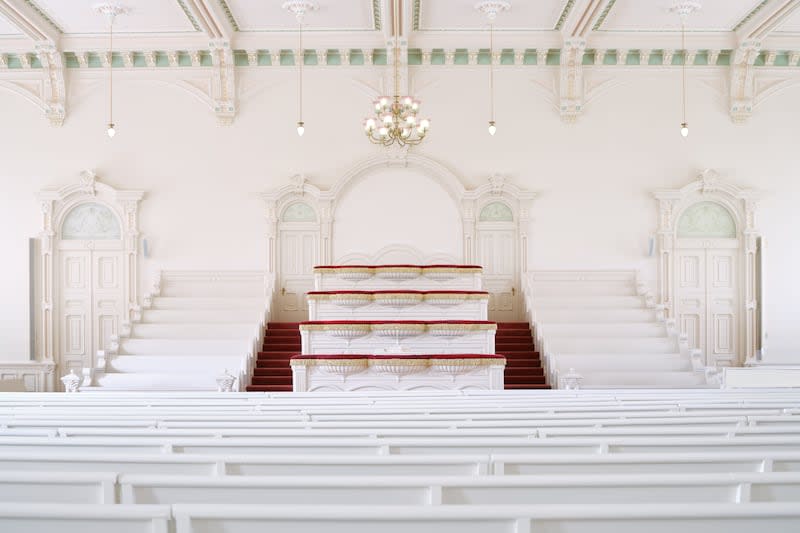
The assembly room and staircase
The 19th-century Latter-day Saint temples — St. George, Logan, Manti, Salt Lake — have assembly rooms on upper floors, Utt said.
Pulpits stand on each end, one for Melchizedek Priesthood in the east, under the higher tower which also represents the higher priesthood that includes the sealing power, and Aaronic Priesthood in west.
Large windows line the long side walls of the massive hall.
“Imagine this room in 1888 before electricity,” said Sister Alexis Schmitt. “The chandeliers that you see throughout the temple all came later. You can see that those that built the temple allowed the natural light to come in, and I think that’s indicative of what we feel here, the light of Jesus Christ.”
The windows throughout the temple also provide a connection between the ideal and the practical reality, Utt said.
The entire Assembly Room is still original, except for upholstery on the pulpits.
Elder Martínez noted the intricate designs on the woodwork. Even the doorknobs and hinges, which are black and brass, include intricate symbols.
“The intricacy is devotion,” he said.
Nothing is more intricate than the two spiral wooden staircases, marvels of pioneer engineering. Each of the 151 steps in each staircase supports the others. The north staircase circles clockwise. The south staircase circles counterclockwise. Each makes six complete circles and rises over 76 feet, according to “The Manti Temple.”
In 1988, it was determined they were two of three large stairways with no central support in the United States. The other was in the Octagon, headquarters for the American Institute of Architects.
The original work was so good that the Manti Temple is the most well-preserved of the pioneer temples.
“The renovation of this temple was a very minor project, relatively speaking,” Utt said. “Some rooms we just shut the door and walked away for two years, and the spiral staircases were one of those areas. We came in at the end of the project and we did a little paint touch up where things had been nicked over the years, but we didn’t replace the carpet. We didn’t clean any of it. We just shut the door. So the spiral staircases, everything is just as they were.”
Other upgrades during the renovation were mechanical, with new equipment for heating and air conditioning and washing temple clothing, Utt said.

